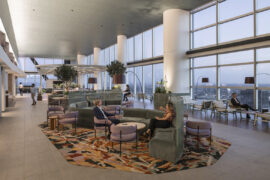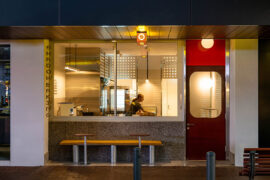CKDS has created distinctive new office space in Newcastle’s CBD following the adaptive reuse of what was previously a theatre.

November 14th, 2023
Theatres are of course an architectural typology of their very own. It’s far from obvious how an office might be created out of one, and this was one of the central challenges facing the architects at CKDS. The original theatre was designed by architect Lawrence Nield and CKDS actually invited him to be part of a design review process as the team applied an approach of adaptive reuse.
“We needed a full understanding of the structural make-up of the existing theatre space. Upon investigation, we found that the tiered seating was integrated to the structure of the building and couldn’t be readily removed,” says Stuart Campbell, CKDS Newcastle studio director.

“In looking at multiple options, we had to work within the confines of the tiered seating staying in place. Beyond that, bringing in natural light was a key consideration. The existing theatre is intrinsically an inward-looking, dark space so in order to convert that to an office environment full of natural light we needed to look at how we might introduce windows and sky lights in a manner that was respectful to the exiting built form.”
Porthole-like windows provide a particularly distinctive way in which light has been brought into the interior for this project. Light enters from similarly shaped sky lights above, but a series of circular apertures on the facade speak to the adaptive reuse informing the new design.

“The two existing arc forms had porthole-like service vents in the upper corners of each,” explains Campbell. “These serve as a distinctive characteristic of the building and something that needed to be retained, celebrated and echoed in the adaptive reuse. We took on the scale and depth of the existing openings and used this as the backbone to introduce new windows into the adapted theatre space.”
Alongside light, the defining features of the project include some strong vertical spaces and an emphasis on circulation. A rather grand atrium void lends prominence to a protagonist staircase whose chunkiness is offset by the fine detailing of balustrades and timber material touches.
Related: Darling Quarter by Hassell, Hammond Studio

“By introducing an atrium void, we can channel natural light down into the lower levels of the building,” says Campbell. “This has the added benefit of creating a walkable link between levels, encouraging community integration and less reliance on the lifts. The stair is designed as light, bright sculptural element that echoes the geometry of the existing arc forms.”
Raised meeting rooms are located just above the lowest floor level, in-keeping with the existing tiered seating layout from the theatre. Higher in the building, larger open-plan offices are organised radially around the stair and atrium space. As Campbell notes, “the radial nature directly relates to the arc form of the existing building and this geometry informed lighting and service layouts.”

Meanwhile, adaptive reuse can hardly be separated from the question of sustainability. While it might often be less flashy than hi-tech solutions to greening the built environment, adaptive reuse represents arguably the single most important and effective approach in making meaningful change. Most simply, it is a way of significantly reducing the enormous waste in the construction and built environment industries.
Campbell explains further: “The most sustainable thing we could do is retain the existing building. By adaptively reusing the space, we are able to realise significant savings in embodied energy and breathe life into an under-utilised space.”

Watt St Commercial is a cohesive coming together of sustainable approaches to architecture with some delightful and distinctive aesthetic touches. The louvres on the external facade are the finishing touch on this “glazed box” now floating proudly in Newcastle’s CBD.
CKDS
ckds.com.au
Photography
Alex McIntyre






We think you might also like this story on DesignOffice’s work for The Commons in Sydney.
INDESIGN is on instagram
Follow @indesignlive
A searchable and comprehensive guide for specifying leading products and their suppliers
Keep up to date with the latest and greatest from our industry BFF's!

At the Munarra Centre for Regional Excellence on Yorta Yorta Country in Victoria, ARM Architecture and Milliken use PrintWorks™ technology to translate First Nations narratives into a layered, community-led floorscape.

Merging two hotel identities in one landmark development, Hotel Indigo and Holiday Inn Little Collins capture the spirit of Melbourne through Buchan’s narrative-driven design – elevated by GROHE’s signature craftsmanship.

Designed by Woods Bagot, the new fit-out of a major resources company transforms 40,000-square-metres across 19 levels into interconnected villages that celebrate Western Australia’s diverse terrain.

In an industry where design intent is often diluted by value management and procurement pressures, Klaro Industrial Design positions manufacturing as a creative ally – allowing commercial interior designers to deliver unique pieces aligned to the project’s original vision.

Working within a narrow, linear tenancy, Sans Arc has reconfigured the traditional circulation pathway, giving customers a front row seat to the theatre of Shadow Baking.

At the Munarra Centre for Regional Excellence on Yorta Yorta Country in Victoria, ARM Architecture and Milliken use PrintWorks™ technology to translate First Nations narratives into a layered, community-led floorscape.
The internet never sleeps! Here's the stuff you might have missed

Boronia Apartments in Waterloo, designed by TURNER for City West Housing, delivers 74 affordable rental homes that combine sustainable design with long-term community-focused living.

AHEC has produced a documentary exploring forestry and stewardship through long-term forest management and human responsibility.